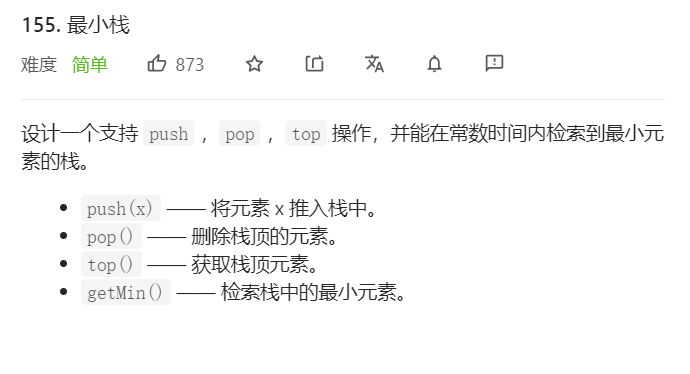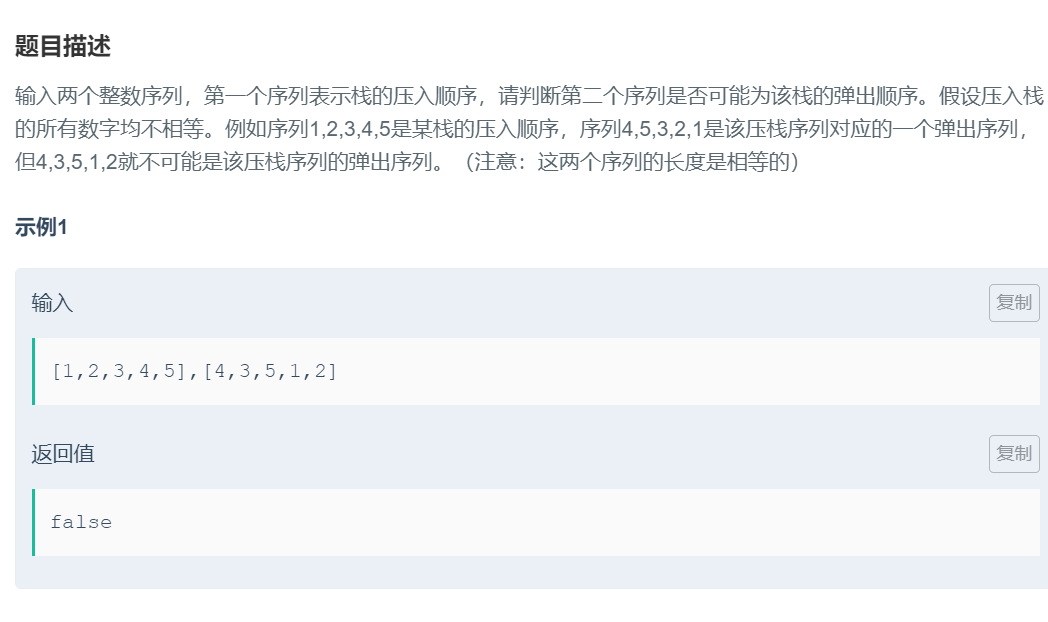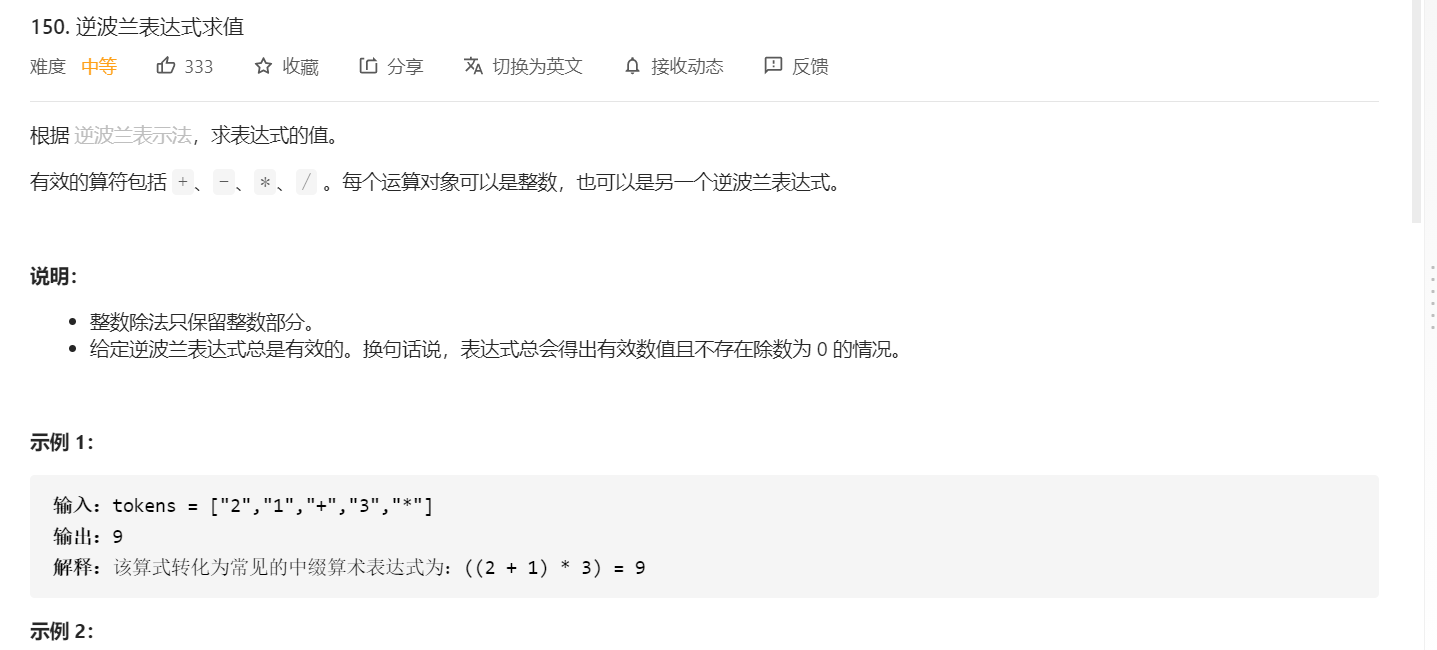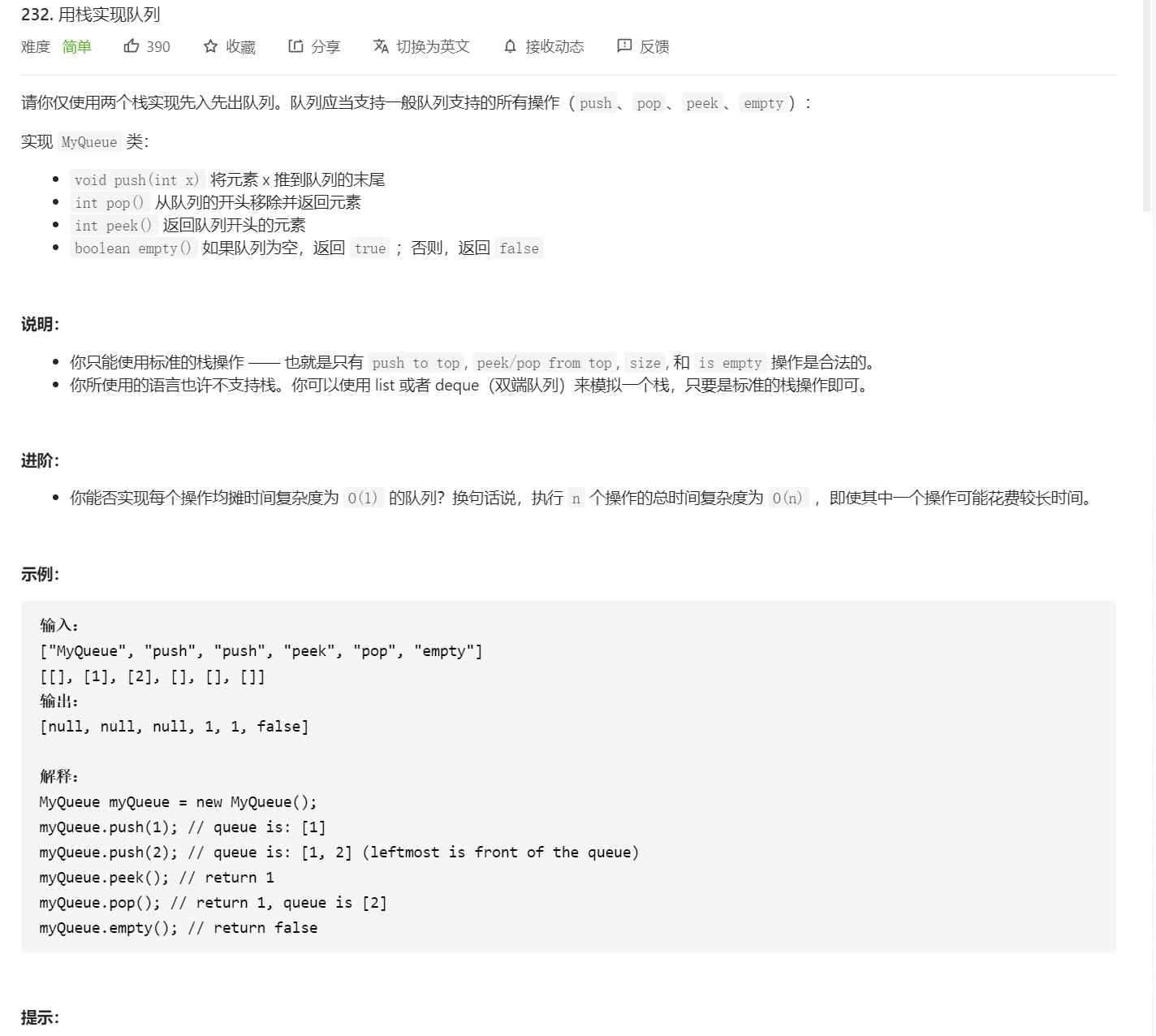| 1. | 最小栈 | 简单 | 跳转 | LeetCode |
| 2. | 压入弹出序列 | 中等 | 跳转 | 牛客 |
| 3. | 逆波兰式计算 | 中等 | 跳转 | LeetCode |
| 4. | 用栈实现队列 | 简单 | 跳转 | LeetCode |
LeetCode 155:最小栈
这道题关键点在于要在常数时间内检索到一个栈中的最小元素,所以我们可以额外实现一个栈,这个栈的栈顶始终保存的是原栈的最小的元素,在插入和删除时都要进行判断
class MinStack {
public:
/** initialize your data structure here. */
MinStack()//如果不写C++也会自动调用stack的默认构造函数
{
}
void push(int val)
{
_elements.push(val);
if(_min.empty() || val<=_min.top())//如果插入的元素要比最小栈的栈顶元素还要小,那么入栈
_min.push(val);
}
void pop()
{
if(_min.top()==_elements.top())//最小栈保存的是元素栈中最小的元素,所以如果它被溢出了,那么最小栈也相应要被移除
_min.pop();
_elements.pop();
}
int top()
{
return _elements.top();
}
int getMin()
{
return _min.top();
}
private:
stack<int> _elements;
stack<int> _min;
};
/**
* Your MinStack object will be instantiated and called as such:
* MinStack* obj = new MinStack();
* obj->push(val);
* obj->pop();
* int param_3 = obj->top();
* int param_4 = obj->getMin();
*/
LeetCode 156:压入弹出序列
这道题比较经典,可以使用栈来模拟这个过程。如下,用pushi扫描pushv,用pushj扫描popv,如果s为空或s的栈顶元素和popv[popj]不相等,说明此时的进栈序列的这个元素不是立马出栈的,因此让其入栈,知道某一个s.top==popv[popj]时,就表明此时可以出栈了,一次类推。
如果最后popj走到了popv的末尾那肯定是满足的情况

class Solution {
public:
bool IsPopOrder(vector<int> pushV,vector<int> popV)
{
if(pushV.size()!=popV.size())
{
return false;//长度不一致
}
stack<int> s;//用s这个栈进行模拟出栈
size_t pushi=0;//用pushi去扫描pushV
size_t popj=0;//用popi去扫描popV
while(popj<popV.size())//一旦不在while循环内return,那么肯定是满足情况的
{
while(s.empty() || s.top()!=popV[popj])//1:空是因为开始的时候栈是空的。2:如果s的栈顶元素不等于出栈序列的对应元素,表明,此时的栈顶元素不是立即出栈的,所以先入栈,待以后出栈
{
if(pushi>pushV.size())//这种情况就是不满足了,因为pushi已经跑到最后了
return false;
else
{
s.push(pushV[pushi]);//进栈
pushi++;
}
}
s.pop();//如果栈顶元素和出栈序列的栈顶元素相等,表明此时出栈序列的该元素应该要出栈了
popj++;
}
return true;
}
};
LeetCode 150:逆波兰表达式求值
这个问题也是栈的经典问题,我在这篇文章专门讲到了这个专题
使用栈解决的一类经典问题:表达式转换及求值
LeetCode 232:用栈实现队列
用两个栈实现队列,s1用来入,s2用来接口操作,入“队列时”直接入s1,pop时如果s2不空那么就先出s2的,因为此时s2里面的是以前的元素,如果s2空了,那么就把s1的元素依次出栈然后入s2,然后再出栈
具体过程可以看这篇博客
数据结构-线性表之用队列实现栈&&用栈实现队列
class MyQueue {
public:
/** Initialize your data structure here. */
MyQueue() {
}
/** Push element x to the back of queue. */
void push(int x)
{
s1.push(x);
}
/** Removes the element from in front of queue and returns that element. */
int pop()
{
if(!s2.empty())//如果s2不空,那么先出s2
{
int temp=0;
temp=s2.top();
s2.pop();
return temp;
}
while(!s1.empty())//如果s2空了,那么把s1的依次出栈,入栈到s2
{
int temp=s1.top();
s2.push(temp);
s1.pop();
}
int temp=0;
temp=s2.top();
s2.pop();
return temp;
}
/** Get the front element. */
int peek()
{
if(!s2.empty())
{
return s2.top();
}
while(!s1.empty())
{
int temp=s1.top();
s2.push(temp);
s1.pop();
}
return s2.top();
}
/** Returns whether the queue is empty. */
bool empty()
{
return s1.empty() && s2.empty();
}
public:
stack<int> s1;
stack<int> s2;
};
最后
以上就是英勇日记本最近收集整理的关于stack经典题的全部内容,更多相关stack经典题内容请搜索靠谱客的其他文章。
本图文内容来源于网友提供,作为学习参考使用,或来自网络收集整理,版权属于原作者所有。












发表评论 取消回复